8.2 Embedding Perl Within Oracle
Running
extproc_perl is mainly about getting the Oracle
external procedures system working correctly. One of the best general
guides we've found for these installation procedures
is Chapter 23 of Oracle PL/SQL Programming,
3rd ed. (now covering
Oracle9i) by Steven Feuerstein with Bill Pribyl
(O'Reilly & Associates, 2002). For further
information on Oracle's external procedures, the
best online information source is perhaps http://technet.oracle.com. Although the pages
are very fluid (you may need to browse around a bit), we found the
following pages useful when we were investigating the
subject:
- http://download.oracle.com/otndoc/oracle9i/901_doc/appdev.901/a88876/adg11rtn.htm
-
Oracle9i Application
Developer's Guide — Fundamentals for Release 1,
Chapter 10.
- http://download.oracle.com/otndoc/oracle9i/901_doc/server.901/a90117/manproc.htm
-
Oracle9i Database
Administrator's Guide for Release 1, Chapter 5.
8.2.1 EXTPROC security
Before you get too deeply into the details
of extproc_perl, we recommend that you check out
the following page for possible security alerts about
EXTPROC, the actual program spawned by the
Oracle external procedure listener processes:
- http://otn.oracle.com/deploy/security/alerts.htm
Because of the nature of what EXTPROC
does — using external libraries to access the inside of the
Oracle database — we have to be vigilant in our use of the
EXTPROC system provided by Oracle. We recommend
that you carefully follow the guidelines provided in any relevant
security advisories you find on the web page we've
referenced previously.
8.2.1.1 extproc_perl and Win32
Like Oracle::OCI,
which we described in the previous chapter,
extproc_perl is still in something
of an experimental stage. At the time this book went to press, there
still wasn't a PPM available for installation on
Win32 systems. Once the module is fully mature,
we're sure it will become available on a PPM
repository. Keep checking at the following page for more details or
at the download sites mentioned in subsequent sections:
- http://dbi.perl.org
(Compilation on Win32, with commercial compilers, should follow the
same logical steps as the Unix installation process described
shortly — your mileage may vary.)
8.2.2 A Detailed Look at extproc_perl
Figure 8-3 and Figure 8-4, in combination, show how we can track the dynamic
calling of an external Perl procedure from within a PL/SQL code
block. (We've also included some Oracle library
configuration information in Figure 8-3 that is
presented in greater detail later in this chapter.)
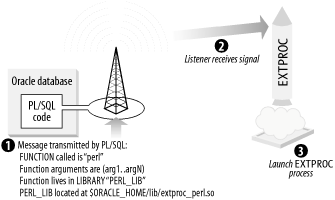
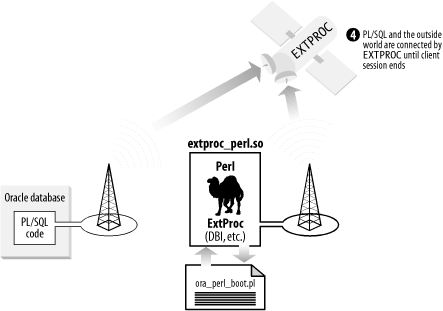
Let's see what's going on here:
From deep within the database, the PL/SQL program broadcasts to the
EXTPROC listener. It sends out targeting
information, stored within library and function declarations, so the
listener can locate the correct code within the external procedure.
It also sends any required parameters.
The listener picks up the signal from the PL/SQL engine. It then launches the EXTPROC rocket program (or
spawns it, as the manuals say, which is too Borg for those of us who
are followers of the One True Kirk.)
Once EXTPROC is deployed, it takes over mission
control, and coordinates the entire operation between the PL/SQL
ground station and the external C program agents. It maps shared code
pages into the address space of the user process and maintains this
link until the client session completes. It then retracts its panels
and splashes back down, to be sent up again on later missions. While
on station, EXTPROC deals with all requests by
the client session for external procedural help.
8.2.3 Downloading extproc_perl
You can download the latest stable version of
extproc_perl from
here:
- http://www.smashing.org
- http://www.cpan.org/modules/by-authors/Jeff_Horwitz
8.2.4 Setting Up External Procedures
Setting up external procedures is not
simple. You will need to do quite a bit of work to get the setup
right. We've summarized the main steps here; in the
following sections we'll show the details for each
point:
Add a tnsnames.ora entry for the
EXTPROC listener process, which calls the
EXTPROC program. This should be installed in
$ORACLE_HOME/bin.
Edit the listener.ora file by adding an entry
for the "external procedure
listener."
Start a separate listener process to exclusively handle external
procedures.
 |
The
EXTPROC process, launched by the listener,
inherits the operating system privileges of the listener. Therefore,
Oracle recommends that privileges for a separate listener process be
made restrictive. They should lack the ability to read or write to
database files or to the server address space. To provide this level
of security, you may want to run your listener as an OS user with
limited permissions, such as nobody.
|
|
Now let's look at the setup details:
With every significant
release of Oracle, the configuration of the .ora
files in $ORACLE_HOME/network/admin seems to
change. We recommend that you refer to your own installation
configuration details for the exact setup required by your system.
We'll concentrate on the logical semantics here,
rather than the exact details for each version. A typical
tnsnames.ora, on the same server as the
listener, should be given a new entry such as the following. (This is
different for Oracle9i; see the discussion later
for details):
extproc_connection_data =
(DESCRIPTION =
(ADDRESS = (PROTOCOL=IPC)(KEY=extproc_key))
(CONNECT_DATA = (SID = extproc_agent)
) In some examples, the basic entry name,
extproc_connection_data, is fixed. However, even
if this is the case in your version of Oracle, it may need a suffix
if your sqlnet.ora contains a default domain
name such as:
NAMES.DEFAULT_DOMAIN=ORACLE.OREILLY.COM You may need to change the server tnsnames.ora
entry name to match the domain name entries as follows:
extproc_connection_data.ORACLE.OREILLY.COM = ... However, the key you specify (in this case
extproc_key) must also match the KEY you specify
in the listener.ora file. In addition, the SID
name you specify (in this case extproc_agent)
must match the SID entry in the listener.ora
file. (You may just want to call everything
extproc to keep it simple.) In the following,
we've attached entries to a new listener entry in
order to run up a separate listener purely for external procedures:
EXTERNAL_PROCEDURE_LISTENER =
(ADDRESS_LIST =
(ADDRESS = (PROTOCOL=ipc)
(KEY=extproc_key)
)
)
SID_LIST_EXTERNAL_PROCEDURE_LISTENER =
(SID_LIST =
(SID_DESC = (SID_NAME=extproc_agent)
(ORACLE_HOME=/u02/app/oracle/product/8.0.4)
(PROGRAM=extproc)
)
)Note the following conditions for the preceding
listener.ora example:
The
EXTPROC program is conventionally referred to as
extproc in lower case.
The
ORACLE_HOME must be set to the Oracle software
home.
The EXTPROC
executable must exist in $ORACLE_HOME/bin.
However, in
Oracle9i, most things are automatic with
PLSExtProc. With a small change to
DBD::Oracle, described later, this is fine.
Let's examine two snippets from the two main
Oracle9i .ora files. First,
listener.ora:
(SID_DESC =
(SID_NAME = PLSExtProc)
(ORACLE_HOME = /opt/oracle/product/9.0.1)
(PROGRAM = extproc)
) And now, tnsnames.ora:
EXTPROC_CONNECTION_DATA.LOCAL =
(DESCRIPTION =
(ADDRESS_LIST =
(ADDRESS = (PROTOCOL = IPC)(KEY = EXTPROC))
)
(CONNECT_DATA =
(SID = PLSExtProc)
(PRESENTATION = RO)
)
) Once ready, we can start up a separate listener as a low-privilege
user:
$ lsnrctl start EXTERNAL_PROCEDURE_LISTENER
Once the listener is running successfully, we can skip the following
section. However, it may prove useful if you encounter any listener
problems.
8.2.5 Debugging External Procedure Listeners
You'll be among
friends if your listener setups refuse to work first time around.
This badge of honor even has a special debug routine to help you;
look for the following file under
ORACLE_HOME:
- dbgextp.sql
Before you install this file, be sure to read it; it contains some
good documentation regarding how you can make use of it with
debugging programs.
Now follow these steps:
In a perfect world, you should get no errors when you execute the
STARTUP_EXTPROC_AGENT procedure. Notice that in
addition to CONNECT and RESOURCE, other important privileges granted
to the new user include both CREATE ANY LIBRARY and DROP ANY LIBRARY:
SQL> connect system/manager
SQL> create user extproctest identified by extproctest;
SQL> grant connect, resource to extproctest;
SQL> grant create any library, drop any library to extproctest;
SQL> connect extproctest / extproctest
SQL> @?/plsql/demo/dbgextp.sql
SQL> call DEBUG_EXTPROC.STARTUP_EXTPROC_AGENT( );
Call completed. If
STARTUP_EXTPROC_AGENT refuses to fire, this will
indicate that the .ora files have a
configuration problem of some kind. Once
everything's ship shape, drop this test user:
SQL> connect system/manager;
SQL> drop user extproctest cascade;
 |
The DEBUG_EXTPROC package can be made to
work with popular C program debug utilities. If you
don't have a debugger on your system and
you're using gcc, you will be
able to use the excellent gdb debugger, which is
designed to work hand-in-glove with gcc. See
http://www.gnu.org/software/gdb/.
|
|
8.2.6 Building a New Perl
Before doing anything else, you will need to
establish whether you're using a Perl distribution
with a shared libperl. This is a pre-condition
for extproc_perl. In the following sections
we'll see how to find this out and how to build a
new Perl if you need to do so.
8.2.6.1 The need for a shared libperl
To find out if you are using a
Perl distribution with a shared libperl, you can
issue the following:
$ perl -MConfig -e 'print "$Config{useshrplib}\n"'
false
Alas, false was the wrong answer. But, every
cloud has a mithril silver lining. Because we're
pointing Perl directly into the heart of the Oracle database,
we'll do as Jeff Horwitz actually recommends and
build a special version of Perl, just for Oracle's
use. This way, we can do all the things we need to do without
clobbering anyone or anything else along the way.
We're also going to make use of a
DBD::Oracle patch, supplied within the
extproc_perl download, to rebuild Perl DBI. This
makes it doubly sensible to break out a fresh Perl to play
with.
Because Oracle lacks support for the dynamic loading of shared
objects from external procedures, Perl's DynaLoader
is compromised. We have to load shared objects from targeted modules
at runtime, and this static architecture requires XS hooks, special
pleading, and a delegation of Papal Nuncios from Rome. Building a
brand new Perl is definitely the way to go!
8.2.6.2 Building Perl for the oracle user
In this section, we'll work through how to build a
brand new Perl for the oracle user. You may want
to breeze through Chapter 2, again to remind
yourself about the basics of Perl installation, but
we'll do an abbreviated installation run right here
and now, and assume that the oracle
user's HOME directory is:
/opt/oracle
If
security is an issue, you may wish to create this new Perl for
whichever user you run your listeners with (see our earlier note on
listener security):
Once the Perl installation user is chosen, you may want to create a
new directory in the $HOME directory (to store
the forthcoming downloads) and a related
perl/bin directory (where we'll
ultimately install Perl):
$ cd $HOME
$ mkdir perldown
$ mkdir -p perl/bin Next, get and unpack stable.tar.gz from
http://www.perl.com/CPAN/src:
$ cd ../perldown
$ gzip -d stable.tar.gz
$ tar xvf stable.tar
$ cd perl-5.6.1 Configure in a shared libperl and a Perl home of
/opt/oracle/perl:
$ rm -f config.sh Policy.sh
$ sh Configure -Dprefix=/opt/oracle/perl -Duseshrplib The configurator will ask lots of questions, depending on your setup.
We have to be careful here and resist pumping the
RETURN key like a Motörhead drummer.
You must say "no" to the following
question:
Many scripts expect perl to be installed as /usr/bin/perl.
I can install the perl you are about to compile also as /usr/bin/perl
(in addition to /opt/oracle/perl/bin/perl).
Do you want to install perl as /usr/bin/perl? [y] n This is an exception; aside from the use of a shared
libperl, we do intend to build a totally
regular, though local, Perl.
Once Perl is configured, run make: $ make You may find time to make a nice hot cup of tea, while the Perl
monkey spends a couple of minutes churning the compilation organ.
When it's completed, check it over:
$ make test
... All tests successful.
u=0.93 s=0.12 cu=64.77 cs=8.81 scripts=249 tests=12503 Now let's go create (note that for once we can avoid
doing this as root):
$ make install At some point during this installation, you may get the following
warning:
Warning: perl appears in your path in the following locations
beyond where we just installed it: /usr/bin/perl This is kind of like a private sentry turning back a known Four Star
General because of a forgotten password; it's a good
thing. To get around this, we must make sure our local hero Perl
comes ahead of any others when we compile our library. Once the
compilation has finished, you'll still see the older
Perl before our nice new sparkling one:
$ type perl
perl is hashed (/usr/bin/perl) We can get round this immediately by resetting
PATH:
$ export PATH=$HOME/perl/bin:$PATH
$ type perl
perl is /opt/oracle/perl/bin/perl (We'll also have to do this more permanently via
whatever profiling system we're using, to ensure
that our oracle user always gets the right
Perl.)
Now, the proof of the Christmas pudding is in the eating, so
let's see if we've acquired the use
of a shared libperl. Go to it, Red:
$ perl -MConfig -e 'print "$Config{useshrplib}\n"'
true
Next, we can move on and install Perl DBI and
DBD::Oracle over the fresh new Perl.
8.2.7 Perl DBI and DBD::Oracle
As Figure 8-5 shows,
once PL/SQL calls the embedded Perl interpreter via external
procedures, it's pretty much out on a limb in the
outside world. Therefore, although we can return ordinary values to
the host database, we need to use DBI (using its own form of SQL) if
we wish to loop back. This loopback behavior is displayed in Figure 8-6. (Notice that we can connect to other
databases as well, although we have to establish a proper connection
in these cases.)
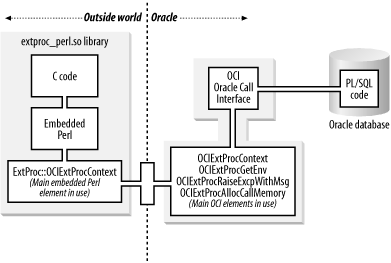
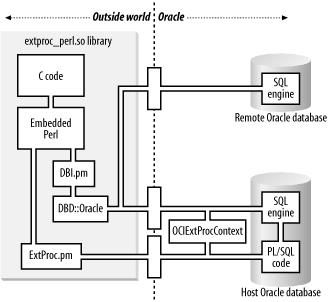
8.2.7.1 The importance of OCIExtProcContext
The
OCIExtProcContext structure from OCI, originally
set up when extproc_perl is first called, gives
DBI the ability to remain within the current PL/SQL transaction. This
prevents the need for a new database connection to be set up.
(We'll say more about this shortly.)
There is a slight complication to DBI, however, caused by the use of
OCIExtProcContext. In order to get DBI to work
within our Oracle Perl interpreter, we needed to apply a patch to
DBD::Oracle. This patch will be included in
versions of DBD::Oracle, from 1.13 onward, but
the extproc_per-0.93.tar.gz tarball we
downloaded had the patch designed for DBD::Oracle
1.08, and we were still on
DBD::Oracle 1.12. To deal with this
incompatibility, we therefore obtained
DBD::Oracle 1.08, just to make sure the patch we
had access to would work as expected. To complete our tarball set, we
obtained the following files, including
Digest::MD5 for testing purposes, and copied
them to
/opt/oracle/perldown:
- http://www.cpan.org/authors/id/TIMB/DBI-1.20.tar.gz
- http://www.cpan.org/authors/id/TIMB/DBD-Oracle-1.08.tar.gz
- http://www.cpan.org/authors/id/JHORWITZ/extproc_perl-0.93.tar.gz
- http://www.cpan.org/authors/id/GAAS/Digest-MD5-2.16.tar.gz
Before we went into combat, we extracted the Perl ammunition:
$ gzip -d *.gz
$ tar xvf DBI-1.20.tar
$ tar xvf DBD-Oracle-1.08.tar
$ tar xvf extproc_perl-0.93.tar
$ tar xvf Digest-MD5-2.16.tar
You may want to get rid of all these .tar files
when you've finished the installation, but we always
tend to keep these until the bitter end, along with our lucky
rabbits' feet.
8.2.7.2 Patching DBD::Oracle
At
this point, you may find it useful to go into the
extproc_perl distribution directory, and check
on the documentation:
Open up the README.DBI. This contains the
information on the DBI patch:
$ cd extproc_perl
$ vi README.DBI We also need to make sure we're using the right Perl: $ type perl
perl is hashed (/opt/oracle/perl/bin/perl) Now we can install DBI, confident that we're dealing
with the right Perl agent (those agents can get tricky when
you've got more than one of them):
$ cd ../DBI-1.20
$ vi README
$ perl Makefile
$ make
$ make test
$ make install
...
Writing
/opt/oracle/perl/lib/site_perl/5.6.1/i686-linux/auto/DBI/.packlist Now the patch comes into play. Go to
DBD::Oracle's installation
home:
$ cd ../DBD-Oracle-1.08 It's time to start up our target Oracle database and
make sure its listeners are fired up. Make sure that
ORACLE_HOME, ORACLE_SID,
and ORACLE_USERID are all set, as per the
DBD::Oracle README
file:
$ export ORACLE_USERID=scott/[email protected]
$ env | grep ORACLE
ORACLE_SID=orcl.world
ORACLE_USERID=scott/[email protected]
ORACLE_HOME=/opt/oracle/product/9.0.1 The DBD::Oracle patch is worth a look if you
have time. You'll notice a sustained use of
OCIExtProcContext and other OCI code elements,
as from Figure 8-5 and Figure 8-6. We've detailed a snippet or
two here:
...
#ifdef OCI_V8_SYNTAX
+ SV **svp;
+ struct OCIExtProcContext *this_ctx;
...
+ if (sv_isa(*svp, "ExtProc::OCIExtProcContext")) {
+ IV tmp = SvIV((SV*)SvRV(*svp));
+ this_ctx = (struct OCIExtProcContext *)tmp;
+ }
...To patch DBD::Oracle, carry out the following
steps:
$ cp dbdimp.c dbdimp.old
$ chmod 644 dbdimp.c Now move down a directory, as the patch is designed to be applied
from the parent directory:
$ cd ..
$ cp extproc_perl/DBD-Oracle.patch .
$ patch -p0 < DBD-Oracle.patch
patching file `DBD-Oracle-1.08/dbdimp.c'
$ cd DBD-Oracle-1.08
$ ls -la dbdimp.* | grep -v '.h'
-r--r--r-- 1 oracle oinstall 57336 Apr 7 12:02 dbdimp.c
-r--r--r-- 1 oracle oinstall 56354 Apr 7 12:01 dbdimp.old Note the slightly larger dbdimp.c file. Oracle9i users and anyone else with a
PLSExtProc listener instance may want to make a
very small manual change to the dbdimp.c file
before compiling. Look for the following
line:
if (!strncmp(dbname,"extproc",7)) is_extproc = 1; Change this to:
if (!strncmp(dbname,"PLSExtProc",10)) is_extproc = 1; This will ensure that the correct database context is called later on. We can now install DBD::Oracle as usual: $ perl Makefile.PL
$ make
$ make test
$ make install
You may also want to install other modules at this point — for
example, Digest::MD5 or anything else from CPAN
that catches your fancy. Because we're embedding
Perl into a C library, we have to embed everything along with it that
we might need later. Fortunately, the main module that makes
extproc_perl possible,
ExtProc.pm, will always be installed
automatically.
8.2.7.3 Connecting back to the host database
As far as the host database
goes, when you call the external procedure you remain permanently
connected to the database as the PL/SQL client user. However, to use
DBI for host callbacks, you can make use of the
OCIExtProcContext object, as noted earlier.
Fortunately, ExtProc.pm has made this easy. You
simply use it to grab the database context from within the bootstrap
.pl script file and then use the following code
to phone
home:
use DBI;
use ExtProc;
# Pick up the current OCI context
my $context = ExtProc::context;
# Call back to the host database
my $dbh = DBI->connect( "dbi:Oracle:extproc", "", "",
{ 'context' => $context });
Here's what's going on:
Notice that there is no user or password required with the
DBI->connect statement.
You're still technically logged into the database as
the user who's running the actual PL/SQL and are
still part of the current transaction.
Notice as well the database SID, extproc within
the DBI driver setup string (you may wish to change this to
PLSExtProc, depending on your setup):
dbi:Oracle:extproc If you choose a more standard connection, such as
dbi:Oracle:orcl, you'll create
a proper DBI connection, which incurs
significant overhead. You'll also need to supply a
user and password. Using dbi:Oracle:extproc is
also much faster, as it's tuned directly into OCI.
Alternatively, if you wish to connect to a remote database or to
connect as another database user, just connect with DBI normally and
follow its standard scott/tiger@my_remote_database_sid
pattern. For example:
my $dbh =
DBI->connect( "dbi:Oracle:my_remote_database_sid", "scott", "tiger",
{ RaiseError=>1, AutoCommit=>0 } );
8.2.8 Installing extproc_perl
We
can now move on to the actual installation of
extproc_perl. Switch over to the
/extproc_perl directory and ritually scan the
installation files:
$ cd ../extproc_perl
$ vi README INSTALL
Note that the INSTALL file is the one you want
to be checking here, rather than README.
8.2.8.1 ora_perl_boot.pl
Before
configuration, we created a bootstrap Perl script file,
ora_perl_boot.pl; at runtime, the C library will scan this
file for functions. ora_perl_boot.pl contains
the subroutines we'll be calling later from within
PL/SQL. The name of this file on the configuration step will default
to:
$ORACLE_HOME/lib/ora_perl_boot.pl
This seems to be a sensible name. We
don't actually have to create this bootstrap file
right now (see the note later in this section), but it seems a good
time to illustrate doing so. In addition, although test routines are
not necessary right now, this also seems as good a time as any to
write some in a new
$ORACLE_HOME/lib/ora_perl_boot.pl file. (See
Example 8-1, and notice our alternative use of
PLSExtProc in Test 4, for database
context.)
Example 8-1. The ora_perl_boot.pl bootstrap file
sub localtime { # Test 1 - What's the time Mr Wolf? :-)
my $x = localtime(time);
return $x;
};
sub ls { # Test 2. ==> Hey, this could be rather dangerous! <==
my ($lsarg) = @_;
$lsarg ||= '.';
my $ls = '/bin/ls -l';
my $lsret = qx( $ls $lsarg );
return $lsret;
}
sub md5hex { # Test 3 - A little enigmatic encryption :)
my ($data) = @_;
use Digest::MD5;
my $ctx = Digest::MD5->new;
$ctx->add($data);
my $digest = uc($ctx->hexdigest);
return $digest;
}
sub tab_keyword { # Test 4 - Using DBI call-back context
# Pick up the current OCI context and recall host.
use DBI;
use ExtProc;
my($keyword) = @_;
my $context = ExtProc::context;
my $dbh = DBI->connect( "dbi:Oracle:PLSExtProc", "", "",
{RaiseError=>1, context => $context});
# Viewing all SYSTEM tables, formatted
my $sth = $dbh->prepare( "SELECT table_name " .
"FROM user_tables ");
$sth->execute;
$sth->bind_columns(\$table_name);
my $return_string;
my $counter = 0;
while ($sth->fetch) {
$table_name = lc($table_name);
$table_name =~ s/($keyword)/uc($1)/ieg; # Hey, Regular
# Expressions!!! 8-)
$counter++;
if ($counter > 4) {
$counter = 1;
$return_string .= "\n";
}
$return_string .= sprintf("%-30s ", $table_name);
}
$dbh->disconnect;
return $return_string;
}
 |
You can create this boot file
after the installation if you wish. As long as the subsequent
installation knows where to expect to find it,
that's good enough. You can also change the boot
file after the installation to add extra subroutines, extra
parameters, and so on. The only restriction is that you must use
basic Perl, pre-installed modules, or pure Perl modules. If you wish
to use a new optional module — for example,
Oracle::OCI — you must rebuild the
extproc_perl.so library with the
Oracle::OCI module explicitly mentioned in the
build process. Everything you wish to use has to be included within
the extproc_perl.so library file, although
rebuilding this is fairly painless once you've
successfully set up the EXTPROC listener
process.
|
|
Example 8-1
is not a polished subroutine collection. At this point,
we'd recommend that you go back and check the
ls( ) subroutine in the example. You could
almost drive a Saturn V rocket through its security (or lack of it)!
(See Figure 8-7 a bit later for more details.) You
will need to watch out for this kind of thing if you employ the
rocket thrust power of extproc_perl. For more on
Perl security, check out:
$ perldoc perlsec
8.2.8.2 Installation steps
Follow these steps to install extproc_perl:
Depending on the Oracle version, some header files may be missing
from the locations where extproc_perl
(originally developed on Solaris) expects to find them. You may have
to symbolically link them in where appropriate. For now, though,
let's assume that all the files are where we need
them:
$ perl Makefile.PL This step will ask several questions. Because of the restriction on
dynamically loaded Perl modules, we have to specifically embed Perl
modules statically within our external procedure library via the
extproc_perl configuration process. The
Makefile.PL configurator will automatically
suggest several modules you might like to include. In addition to
these, we'll also add the DBI,
DBD::Oracle, and
Digest::MD5 modules, which
we'll be testing later via subroutine
md5hex( ) in the boot file:
Modules to include in this
build [IO Socket attrs]: IO Socket attrs Digest::MD5
DBI DBD::Oracle <RETURN>We also accepted the default name and location for the bootstrap file: Path to bootstrap
file [/opt/oracle/product/9.0.1/lib/ora_perl_boot.pl]: <RETURN> It's time to compile: $ make We hope you have as much fun as we did with the
make step!
We can now create our special library file, which also automatically
installs the essential ExtProc.pm Perl module:
$ make install
...
*** You should now copy extproc_perl.so to a convenient location.
... So, Mr. Bond, did we cut the library file from the Monte Carlo card
pack?
$ ls -la *.so
-rwxr-xr-x 1 oracle oinstall 13008 Apr 7 12:18 extproc_perl.so You win again, Mr. Bond, but we'll be back! Having
created a shiny extproc_perl.so library, we
place it where Oracle can find it later.
$ORACLE_HOME/lib seems the most natural place:
$ cp extproc_perl.so $ORACLE_HOME/lib Now there's just one more hurdle before the home
stretch; we'll discuss it in the next
section.
 |
There are two built-in
extproc_perl functions detailed in the
README.special file. The first is
_version, which supplies the current
extproc_perl version, and the second is
_flush, which destroys the current Perl
interpreter and all the Perl data; a new interpreter is started for
the next query. (You'll see
_flush in action at the end of the chapter in
Figure 8-9.)
|
|
8.2.9 Deploying extproc_perl
All
of the operating system elements are now in place for being able to
use extproc_perl. The final task is the creation
of the actual PERL_LIB library within the
database and its associated perl function.
We'll do this in Example 8-2; you
can change this code and add more parameters to suit your own
environment, either now or at a later time.
Example 8-2. Creating the PERL_LIB library and perl function
CREATE OR REPLACE LIBRARY PERL_LIB IS
'/opt/oracle/product/9.0.1/lib/extproc_perl.so'
/
show error library perl_lib
CREATE OR REPLACE FUNCTION perl (
sub IN VARCHAR2, arg1 in VARCHAR2 default NULL,
arg2 in VARCHAR2 default NULL, arg3 in VARCHAR2 default NULL,
dummy in VARCHAR2 default NULL
) RETURN STRING AS
EXTERNAL NAME "ora_perl_sub"
LIBRARY "PERL_LIB"
WITH CONTEXT
PARAMETERS (
CONTEXT,
RETURN INDICATOR BY REFERENCE,
sub string,
arg1 string,
arg1 INDICATOR short,
arg2 string,
arg2 INDICATOR short,
arg3 string,
arg3 INDICATOR short,
dummy string,
dummy INDICATOR short
);
/
show errors function perl;
create public synonym perl for perl;
grant execute on perl to public;
8.2.10 Testing extproc_perl
To
recap, here's what we've done to
get ready to run extproc_perl:
The external procedure listener is running and ready to spawn
EXTPROC.
The PERL_LIB library has been created, along
with the related perl function, and has been
made available to public.
The extproc_perl.so library has been compiled
and is accessible to EXTPROC.
The ora_perl_boot.pl bootstrap file has been put
in place; it is waiting now for calls from the
perl function via
extproc_perl.
Oh, what a tangled web we've woven — but one
with a huge potential problem. Let's do some
testing. You can see our first two tests being called in Figure 8-7; note the security implications of our
ls subroutine. Figure 8-8
shows our third test; note how the addition of the
md5hex encryption subroutine adds a necessary
degree of security.

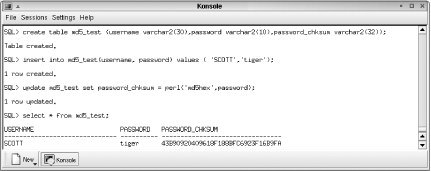
Figure 8-9 shows our final context link back to
Perl DBI, and the use of regular expressions. This Perl
routine's purpose is to list all of the tables in
USER_TABLES and to highlight a chosen string — in this case,
COL. Notice the use of
_flush, the built-in function that clears out
the Perl interpreter beforehand.
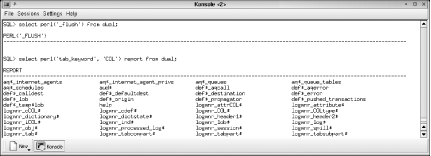
As Laurence Olivier might have said, we'll leave it
to your imagination to fill in the many and varied possibilities of
using extproc_perl. Suffice it to say that
through extproc_perl you now have the entire
range of Perl and CPAN modules to play with — including mailing,
regular expressions, FTP, Telnet, IO::Socket,
and all the other golden gems of Perl Internet functionality. If
you're interested in encryption and related security
operations, you'll find that you now have a full
range of Perl security modules available, including
Authen::ACE,
Crypt::Beowulf, the various message digest
algorithms, and the Crypt::Twofish2 encryption
module. You can see the ever-growing list of Perl security modules at
http://search.cpan.org/Catalog/Security/.
|









